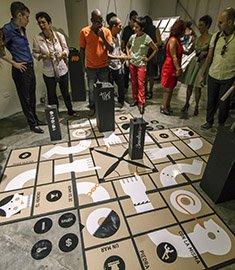
Iglesia del Santo Cristo del Buen Viaje LH  3
3
Erected in 1640 simultaneously with the Plaza del Cristo around the Ermita del Humilladero–the final station of the Vía Crucis or procession of the Stations of the Cross on Good Friday, which started …
 ColonialAdmission: FreeOpen: 9am-6pm, Tues-SunVillegas e/ Lamparilla y Teniente Rey, Habana Vieja
ColonialAdmission: FreeOpen: 9am-6pm, Tues-SunVillegas e/ Lamparilla y Teniente Rey, Habana Vieja 
Museo de los Bomberos LH  3
3
This singular 1910 Fire Station has a simple but refined façade that features a kind of triumphal arch dominated by a central double-heighted void. Today, it houses a lovely museum about the history o …

Museo del Tabaco LH  3
3
Housed in an 18th-century mansion that once belonged to merchant Don Bartolomé Luque, this modest museum displays lithographic prints, old pipes and lighters, early cigar boxes and ashtrays, furniture …

Fundación Alejo Carpentier (Casa de la Conde de la Reunión) LH  3
3
On Empedrado Street, between Cuba and San Ignacio, a few doors from the famous Bodeguita del Medio, stands this building which belonged to Don Santiago de la Cuesta, Conde de la Reunión. Its style is …
 BaroqueAdmission: FreeOpen: 8:30am-4:30pm Mon-FriEmpedrado #215, e/ Cuba y San Ignacio, Habana Vieja
BaroqueAdmission: FreeOpen: 8:30am-4:30pm Mon-FriEmpedrado #215, e/ Cuba y San Ignacio, Habana Vieja 
Casa Víctor Hugo LH  3
3
This institution is supported by donations from Ediciones Boloña, a publishing house of the City Historian’s Office. Its purpose is to make known the work of the famous French author Victor Hugo, as w …

Templo Nacional Masónico LH  3
3
This building of imposing image is an example of conventionalism at a time when the architectural avant-garde had already paved the way for new, bolder ideas. From that premise, however, this construc …
 Art DecoCarlos III (Avenida Salvador Allende) #506-508 esquina a Belascoaín (Padre Valera)
Art DecoCarlos III (Avenida Salvador Allende) #506-508 esquina a Belascoaín (Padre Valera) 
Faro O’Donnell LH  3
3
The original lighthouse at the Castillo de los Tres Reyes del Morro was erected on the Morrillo Semibastion and was fueled by wood until the 17th century, then by gas until the 19th century and finall …

Casa del Benemérito de las Américas Benito Juárez LH  3
3
Housed in the former 18th-century mansion of the Pedroso y Herrera family, this museum is named for Mexican president Benito Juárez, who visited Havana in 1853 and 1862. It has four rooms dedicated to …

Casa del Capitán Gaspar Rivero de Vasconcelos LH  3
3
On the corner of Obrapía and San Ignacio Streets, one block west of Mercaderes, stands one of the oldest and best preserved homes in Havana, and despite its relatively simplicity, one of its most stri …
 ColonialAdmission: FreeObrapía #172, Habana Vieja
ColonialAdmission: FreeObrapía #172, Habana Vieja 
Museo de Arqueología (Casa de Juana Carvajal) LH  3
3
Housed in the Casa de Juana Carvajal, this museum is the result of archaeological studies in the Historic Center and the preservation efforts made by the City Historian’s Office. Inside is a fascinati …
 ColonialAdmission: CUC 1Open: 9am-4:30pm Tues-SunCuba #12 e/ O’Reilly y Empedrado, Habana Vieja
ColonialAdmission: CUC 1Open: 9am-4:30pm Tues-SunCuba #12 e/ O’Reilly y Empedrado, Habana Vieja 












